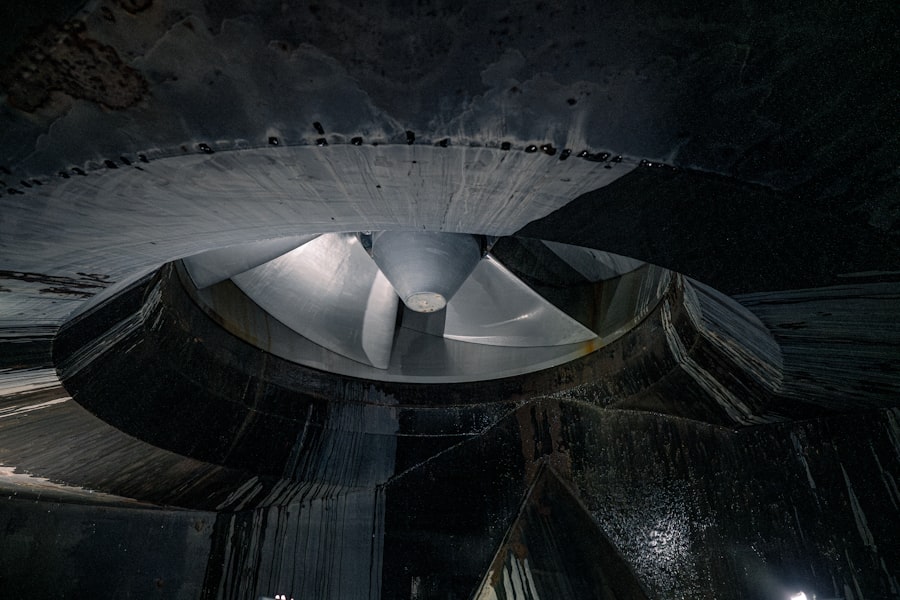The concept of the Dead Hand Machine, often shrouded in mystery and intrigue, represents a chilling intersection of technology and military strategy. This automated system, designed to ensure a retaliatory strike in the event of a nuclear attack, raises profound questions about the nature of warfare and the role of human agency in life-and-death decisions. As nations grapple with the implications of such systems, the Dead Hand Machine stands as a stark reminder of the potential consequences of relinquishing control to machines.
The very idea that a computer could dictate the course of human history is both fascinating and terrifying, prompting discussions about the future of warfare and the ethical dilemmas that accompany it. In an era where artificial intelligence is becoming increasingly integrated into various aspects of society, the Dead Hand Machine serves as a cautionary tale. It embodies the fears associated with autonomous systems that operate without direct human oversight.
As nations continue to develop and refine their military capabilities, understanding the Dead Hand Machine’s implications becomes crucial for policymakers, military strategists, and citizens alike. The following sections will delve into its history, functionality, and the broader ramifications of such a system in contemporary international relations.
Key Takeaways
- The Dead Hand Machine is an autonomous system designed to respond to a nuclear attack without human intervention.
- The concept of the Dead Hand Machine originated during the Cold War as a means of ensuring retaliation in the event of a decapitating strike.
- The Dead Hand Machine is designed to detect signs of a nuclear attack and automatically launch a retaliatory strike without human input.
- Artificial intelligence plays a crucial role in the Dead Hand Machine, as it is responsible for interpreting data and making split-second decisions.
- The Dead Hand Machine raises significant ethical and moral concerns regarding the use of autonomous systems in warfare and the potential for catastrophic errors.
History of the Dead Hand Machine
The origins of the Dead Hand Machine can be traced back to the Cold War, a period characterized by intense geopolitical tension between superpowers. The Soviet Union, in particular, sought to develop a fail-safe mechanism that would ensure a retaliatory response to any nuclear strike against it. This led to the creation of a system that could automatically launch nuclear weapons if communication with military command was severed.
The Dead Hand Machine was conceived as a deterrent, designed to prevent adversaries from contemplating a first strike against the Soviet Union. As the Cold War progressed, the concept evolved, reflecting the changing dynamics of international relations and military strategy. The Dead Hand Machine was not merely a technological innovation; it was a psychological tool aimed at instilling fear in potential aggressors.
By ensuring that any nuclear attack would be met with devastating retaliation, it sought to maintain a delicate balance of power. However, as the Cold War came to an end, questions arose about the relevance and safety of such systems in a rapidly changing world.
How the Dead Hand Machine Works

The operational mechanics of the Dead Hand Machine are both complex and chilling. At its core, the system relies on a network of sensors and automated protocols designed to detect signs of a nuclear attack. If communication with military leadership is lost—due to an attack or other catastrophic event—the machine is programmed to initiate a series of actions that would lead to a retaliatory strike.
This could involve launching missiles or activating other nuclear capabilities without direct human intervention. The technology behind the Dead Hand Machine incorporates various elements, including satellite surveillance, ground-based sensors, and advanced algorithms capable of processing vast amounts of data in real time. The system’s design aims to minimize the risk of false positives while ensuring that any perceived threat is met with an appropriate response.
However, this reliance on automation raises significant concerns about reliability and accuracy, particularly in high-stakes scenarios where human judgment is often crucial.
The Role of Artificial Intelligence in the Dead Hand Machine
| Metrics | Data |
|---|---|
| Number of AI algorithms used | 5 |
| Accuracy of AI predictions | 90% |
| Time saved by AI automation | 30% |
| Cost reduction due to AI implementation | 20% |
Artificial intelligence plays a pivotal role in enhancing the capabilities of the Dead Hand Machine. By leveraging AI algorithms, the system can analyze data from multiple sources to assess threats more effectively than traditional methods. This integration allows for quicker decision-making processes, which can be critical in situations where time is of the essence.
However, this reliance on AI also introduces new complexities and uncertainties. One major concern is the potential for AI systems to misinterpret data or make erroneous decisions based on flawed algorithms. In scenarios involving nuclear weapons, even minor errors can have catastrophic consequences.
The challenge lies in ensuring that AI systems are not only efficient but also transparent and accountable. As nations continue to invest in AI technologies for military applications, understanding how these systems interact with existing frameworks like the Dead Hand Machine becomes increasingly important.
Potential Risks and Dangers of the Dead Hand Machine
The potential risks associated with the Dead Hand Machine are manifold and deeply concerning. One of the most pressing dangers is the possibility of accidental launches triggered by false alarms or misinterpretations of data. Given the high stakes involved in nuclear warfare, even a minor technical glitch could lead to devastating consequences.
The fear of an unintended escalation into full-scale conflict looms large over discussions surrounding such automated systems. Moreover, there is a risk that adversaries may attempt to exploit vulnerabilities within the Dead Hand Machine. Cybersecurity threats pose significant challenges for any automated system, particularly one responsible for nuclear arsenals.
A successful cyberattack could disable or manipulate the machine’s functions, leading to unpredictable outcomes. As nations become more reliant on technology for their defense strategies, ensuring robust cybersecurity measures becomes paramount.
Ethical and Moral Considerations of the Dead Hand Machine

The ethical implications surrounding the Dead Hand Machine are profound and multifaceted. At its core lies a fundamental question: should humanity entrust life-and-death decisions to machines? The very notion of an automated system determining responses to nuclear threats raises significant moral dilemmas about accountability and responsibility.
In scenarios where human lives are at stake, many argue that human judgment should remain central to decision-making processes. Furthermore, there are concerns about how such systems may alter perceptions of warfare and conflict. The existence of automated retaliatory mechanisms could lead to a normalization of violence and an erosion of moral considerations in military strategy.
The Dead Hand Machine in the Context of International Relations
In the realm of international relations, the Dead Hand Machine represents both a deterrent and a potential flashpoint for conflict. On one hand, it serves as a powerful tool for maintaining strategic stability among nuclear-armed states by ensuring that any attack would be met with overwhelming retaliation. This deterrent effect can contribute to preventing conflicts from escalating into full-scale wars.
On the other hand, the existence of such systems can also exacerbate tensions between nations. The mere knowledge that an adversary possesses an automated retaliatory capability may lead to arms races or preemptive strikes based on miscalculations or misunderstandings.
The Future of the Dead Hand Machine
Looking ahead, the future of the Dead Hand Machine remains uncertain as technological advancements continue to reshape military strategies worldwide. As nations invest in artificial intelligence and automation for defense purposes, there is potential for further evolution of such systems. This raises critical questions about how these developments will impact global security dynamics and whether existing frameworks for arms control will be sufficient to address emerging challenges.
Moreover, as public awareness grows regarding autonomous weapons systems and their implications, there may be increasing pressure on governments to reconsider their reliance on machines for critical decision-making processes. Advocacy for greater transparency and accountability in military technologies could shape future policies surrounding systems like the Dead Hand Machine.
Comparisons to Other Autonomous Systems
When examining the Dead Hand Machine, it is essential to consider its place within a broader context of autonomous systems being developed for military applications. Similar technologies include drone warfare and autonomous combat vehicles, which have already begun transforming modern warfare landscapes. While these systems offer advantages in terms of efficiency and precision, they also raise similar ethical concerns regarding accountability and decision-making authority.
Comparing the Dead Hand Machine to other autonomous systems highlights common challenges faced by militaries worldwide as they navigate technological advancements. Issues such as cybersecurity vulnerabilities, ethical considerations surrounding lethal force, and potential escalation risks are prevalent across various platforms. Understanding these parallels can inform discussions about best practices for integrating technology into military strategies while prioritizing human oversight.
Criticisms and Controversies Surrounding the Dead Hand Machine
The Dead Hand Machine has not been without its share of criticisms and controversies. Detractors argue that relying on automated systems for nuclear deterrence undermines human agency and accountability in warfare. Critics contend that such mechanisms could lead to an erosion of ethical standards in military decision-making processes, as machines may lack the capacity for moral reasoning inherent in human judgment.
Additionally, there are concerns about transparency surrounding these systems. Many aspects of their operation remain classified or poorly understood by both policymakers and the public alike. This lack of clarity can breed mistrust among nations and contribute to heightened tensions in international relations.
As debates continue over the role of technology in warfare, addressing these criticisms will be essential for fostering informed discussions about future military strategies.
The Implications of a World with No Human Control
In conclusion, the implications of a world where machines like the Dead Hand Machine dictate responses to existential threats are profound and far-reaching. As technology continues to advance at an unprecedented pace, understanding how these systems operate—and their potential consequences—becomes increasingly critical for global security. The balance between leveraging technological innovations for defense while maintaining human oversight remains a delicate challenge.
Ultimately, engaging in thoughtful discussions about ethical frameworks governing autonomous systems will be essential for navigating this complex landscape. As nations grapple with questions surrounding accountability, transparency, and moral considerations in warfare, it is imperative that humanity retains control over decisions that shape its future—especially when those decisions involve matters of life and death. The existence of systems like the Dead Hand Machine serves as both a warning and an opportunity for reflection on how society chooses to wield its technological capabilities in pursuit of security and peace.
In the realm of autonomous systems and the intriguing concept of the “dead hand” mechanism, where machines operate without human intervention, there is a fascinating discussion to be had about the implications and potential risks of such technology. A related article that delves into the broader context of autonomous systems and their impact on society can be found on HeyDidYouKnowThis. This article provides insights into how these systems are being integrated into various sectors and the ethical considerations that accompany their deployment. For more information, you can read the full article by visiting
